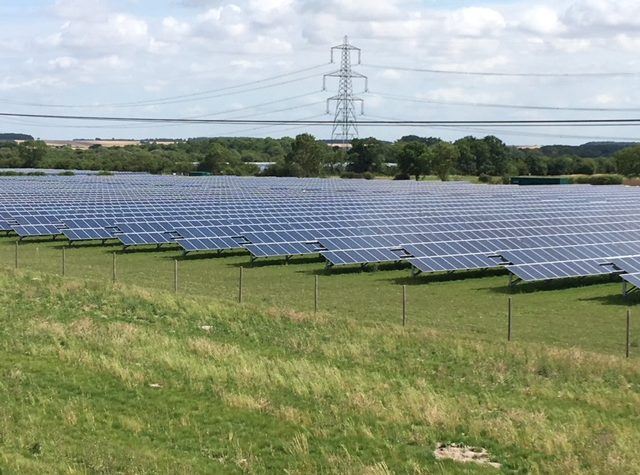Renewables have a major role to play in the future of the UK’s energy system. It is widely accepted that they will be an important aspect of solving the energy trilemma: how to reduce carbon emissions, keep energy costs down and ensure security of supply.
Where opinions differ is how much further we can, and should, rely on renewables for our energy generation in the longer term – and how much we should use other low carbon technologies, such as nuclear, to keep the lights on and the costs down while meeting our climate targets. Our National Infrastructure Assessment has proposed a significant increase in renewables over the coming decade. Renewables are low on waste, cheap to run and their costs have been falling sharply, but they generate energy intermittently. Wind and solar, likely to be the primary sources of renewable energy, are dependent on the weather and so other sources of energy flexibility such as storage technologies become important. Nuclear on the other hand produces a reliable baseload of low carbon energy, but the costs have not shown significant scope to fall and they produce radioactive waste, which needs careful management to protect the public and the environment.
Predicting the optimal future energy mix is difficult. We can’t be sure where the biggest cost reductions will be or how new generating and storage technologies, a research area with significant academic and commercial momentum, might develop. Nor can we be certain how demand might grow and change over time or what the effect of smart technologies, such as smart charging electric vehicles and vehicle to grid technology, will be.
The weather is also a crucial factor for renewables, but this is notoriously variable and difficult to predict. The energy mix, where it includes a large portion of weather dependent technologies such as wind and solar, needs to be resilient to weather changes from hour to hour, season to season and year to year but also to the more rare and extreme stress events such as extended periods without wind or sun.
One of the other big unanswered questions is whether our heating will be provided primarily by electrification in the form of heat pumps or through converting the gas grid to hydrogen. The answer will have an impact on electricity demand, with people mostly heating their homes in the evening, where demand on the electricity grid is already at its peak.
For the National Infrastructure Assessment, we commissioned analysis of the future energy system costs from Aurora Energy Research which took account of the variability of the weather, as well as potential changes in energy usage and technology costs. Weather variability was modelled down to every half hour using data based on an average year, although variations between different years was not modelled. This may mean that the requirement for flexible generation or storage capacity was underestimated compared with what would be required during more extreme weather events such as longer periods without wind and sun. On the other hand, only current generation and storage technologies, and their expected cost reductions, were incorporated into the model; while new and developing generation and storage technologies, which could yet have a major impact, were not included because their potential is so uncertain. Vehicle to grid technology was assumed to be used primarily in van fleets and only to a limited extent by car owners. Again, as technology develops this could have a more significant impact.
Based on these assumptions, the modelling indicated that the climate targets and electricity demand up to 2050 could be met without adding to the cost of energy. It also showed that the system costs were broadly the same right through from a mix of low renewables and high nuclear (40% of generation from renewables) to a highly renewable mix (90% of generation from renewables), with the lowest system cost occurring when 70-80% of electricity generation came from renewables. These results held whether heating was provided through electrification or hydrogen.
Two days after the publication of these results in the Assessment, National Grid published the 2018 edition of its annual Future Energy Scenarios document, which looks to show credible pathways for the future of energy for Great Britain. For the first time two of the four scenarios met the 2050 climate targets. Both of those scenarios showed renewables providing over 70% of electricity generation in 2050, and both already had over 60% of generation from renewables by 2026.
We approached the Assessment without any preconceived preference for how best to meet carbon targets. On the results of our, and National Grid’s, analysis, it is beginning to look likely that a highly renewable energy system, with some nuclear, may provide the best way of solving the energy trilemma. To keep our options open, renewable generation should therefore ramp up significantly over the coming decade.
There are uncertainties on both sides, nuclear may yet find ways of reducing costs significantly, but renewable generating technologies have demonstrated the greatest potential to exceed expectations on cost reduction to date. Storage technologies have also shown great improvements so far and there is plenty of commercial impetus to keep innovating – not least from the switch to electric vehicles and battery storage technology. If this keeps progressing the case for renewables may become even stronger.
We need to be sure that a system based on variable, weather dependent, renewables is resilient. More needs to be done, for example, to look at how a highly renewable system will deal with weather extremes, how much interconnections with other countries can be relied upon, and what the potential is for new and developing technologies to play a role.
Building capacity up to deliver at least 50 per cent of renewable generation by 2030 opens up the possibility of a transition to an even higher proportion of renewable generation while providing a better sense in practice of how such a system might perform. In the meantime, we should not abandon the pipeline of nuclear projects, and so our Assessment still builds in scope for government to support one more nuclear plant after Hinkley Point C by 2025, which would keep the option of meeting carbon targets with a nuclear fleet open. But an energy system based on renewables no longer looks like pie in the sky, but increasingly like a feasible scenario, which could well make the most economic sense to pursue.
Pete Burnill is a senior policy adviser at the National Infrastructure Commission




